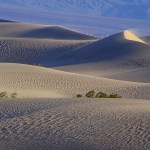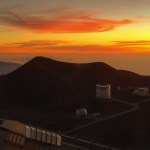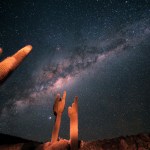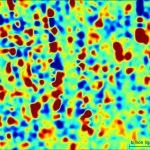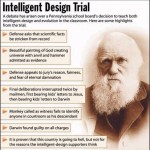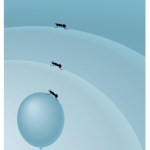Cosmology
This is an enhanced version (with some upgraded images and text) of an article I first wrote over two years ago. It is just as valid today as it was back then, only today, I have a special offer to go with it. Next week, a bunch of cosmologists and myself are getting together and all writing about dark energy. And I want you to have your say.
So at the end of this post, ask your dark energy questions. Ask anything and everything you ever wanted to know about dark energy. I'll choose the best one (or, space & time permitting, more than one) and write a special post on it for you then.…
"The greatest enemy of knowledge is not ignorance, it is the illusion of knowledge." -Stephen Hawking
The Universe is a vast, seemingly unending marvel of existence. Over the past century, we've learned that the Universe stretches out beyond the billions of stars in our Milky Way, out across billions of light years, containing close to a trillion galaxies all told.
Image credit: NASA, ESA, S. Beckwith (STScI) and the HUDF Team.
And yet, that's just the observable Universe! There are good reasons to believe that the Universe continues on and on beyond the limits of what we can see; the…
"Art has never been a popularity contest." -James Levine
Sometimes, you might feel like you've heard it all, seen it all, and that nothing's original anymore. But I beg to differ. Just because great things have come before doesn't mean that there aren't great things happening right now. While it might "only" be a cover of a Kanye West song (which itself heavily samples a Ray Charles song, at one time featured here), I encourage you to listen to the Automatic's brilliant version of
Gold Digger.
And while the stories of the Universe I tell you about here don't tend to be my personal, original…
"You don't use science to show that you're right, you use science to become right." -Randall of xkcd
In January of 2008, I began writing this blog, Starts With A Bang, both for myself and for all of you, because we all have something in common.
Image credit: © Stéphane Guisard, "Los Cielos de Chile", via astrosurf.com.
The same planet, the same heavens, the same laws of nature and the same Universe are something that we all have in common. And all of us, no matter how intrinsically smart, talented, or brilliant our instincts are, come into this world knowing absolutely…
Imagine looking in the mirror and finding your familiar face reflected back as you've always known it. But as you look more closely, as you precisely examine that mirror image, subtle distortions emerge. The glass itself remains flawless, but real and fundamental differences exist between you and the face that lives on the other side of the looking glass.
Something similar happens in the quantum world when matter is examined against its exotic reflection: antimatter. The analogy is admittedly fanciful, but it's no more dramatic than the dynamics of these almost-twins, which annihilate one…
On Brookhaven Bits & Bytes, Kendra Snyder shows us new images from the Sloan Digital Sky Survey III, which analyzed the light of 14,000 distant quasars to map the ancient universe in 3-D. Hydrogen gas absorbs the light from quasars at certain wavelengths, generating a pattern known as the "Lyman-alpha forest" and allowing researchers to model the gas as it was distributed 11 billion years ago. Ethan Siegel puts this time period in context in his exhaustive cosmic history, which starts before the Big Bang and stretches a quadrillion years in the future. The universe eventually "goes dark…
What did the universe look like 11 billion years ago? Something like this:
This image is part of the largest-ever 3-D map of the distant universe, which was released yesterday by scientists from the Sloan Digital Sky Survey III (SDSS-III) at the April meeting of the American Physical Society. Just a slice of the entire map, the image shows the distribution of intergalactic hydrogen gas: red areas have more gas, blue areas have less.
Scientists usually map the universe by looking at galaxies. But this study, which was led by Brookhaven cosmologist Anže Slosar, observed how light from…
This guest post is written by BNL cosmologist Anže Slosar. Slosar, who joined Brookhaven's physics department in 2009, received his Ph.D. from Cambridge University in 2003. He previously worked at Lawrence Berkeley National Laboratory, Oxford University, and the University of Ljubljana in Slovenia.
Anže Slosar
Brookhaven Lab is involved in three cosmology experiments aimed at unraveling deep mysteries and inner workings of the universe. Two of these -- the Dark Energy Survey (DES) and Large Synoptic Survey Telescope (LSST) -- won't see "first light" (the beginning of commissioning)…
Not long ago, a new preprint on the fine structure constant got a bunch of press, nicely summed up by the Knight Science Journalism Tracker last week. I meant to say something about this last week, but what with it being the first week of classes and all, I didn't find the time.
I still think it's worth writing about, though, so after a reproduction of the key figure, we'll have the usual Q&A-format explanation of why I don't quite trust this result:
So what's this all about? The preprint in question is the latest in a series of attempts to measure possible changes in the fine structure…
Earlier this week, there was some interesting discussion of science communication in the UK branch of the science blogosphere. I found it via Alun Salt's "Moving beyond the 'One-dinosaur-fits-all' model of science communication" which is too good a phrase not to quote, and he spun off two posts from Alice Bell, at the Guardian blog and her own blog, and the proximate cause of all this is a dopey remark by a UK government official that has come in for some justifiable mockery.
Bell and Salt both focus on the narrowness of the "dinosaurs and space" approach-- a reasonably representative quote…
The Science Channel debuted a new show last night, Through the Wormhole with Morgan Freeman, with the premier apparently designed by committee to piss off as many Internet types as possible. The overall theme was "Is there a creator?" and it featured physicist-turned-Anglican-priest John Polkinghorne talking about fine-tuning but no atheist rebuttal. It spent a good ten minutes on Garrett Lisi and his E8 theory, making it sound a whole lot more complete than it is. And it got this aggressively stupid review in the Times:
Oh, let's face it: it was hard to concentrate on the first half of the…
Space has a way of inspiring the imagination more than almost any other scientific field. When we talk about making huge investments of money and brainpower to solve some looming problem--say, the need for renewable energy--we talk about making a new moon shot. And while some of the most exciting scientific discoveries are being made right now on the smallest scales imaginable, there is something about the grandness of both time and distance that makes space truly the final frontier.
Drawing out the comparisons between investigating the infinitesimal and the infinite, astronomy is the only…
Via Jennifer Ouellette on Twitter, I ran across a Discovery News story touting a recent arxiv preprint claiming to see variation in the fine-structure constant. It's a basically OK story, but garbles a few details, so I thought it would be worth giving it the ResearchBlogging treatment, in the now-traditional Q&A format.
What did they do? The paper looks at some spectral lines in radio emission from a moderately distant galaxy with the poetic name "PKS1413+135." These lines are produced by OH molecules in interstellar gas clouds, and the frequencies they see suggest that there may have…
tags: astronomy, cosmology, black obelisks, Dwarf Galaxy Dance, formation of dwarf galaxies, cold dark matter model, NPG, peer-reviewed research, NATURE, 10.1038/nature08640, streaming video
This beautiful animation shows how exploding stars are a key force in shaping dwarf galaxies. Fabio Governato and colleagues present computer simulations that appear to have solved a longstanding problem in cosmology -- namely, how the standard cold dark matter model of galaxy formation can give rise to the dwarf galaxies we see around us.
DOI: 10.1038/nature08640.
Andrew Lange RIP.
Andrew Lange - story at Cosmic Variance
Lange's "How DId the Universe Begin" Segre Distinguished Lecture at Berkeley Nov 2009.
Lange's 2004 KITP talk on "Future Directions in Cosmic Microwave Background Observations"
Audio/Web Cam
In my mind, and in my car,
we can't rewind, we've gone too far,
pictures came and broke your heart,
put the blame on VTR.
And for those of you who are under the age of 25, VTR stands for Video Tape Recorder. This was the Buggles, who made the first music video that ever appeared on MTV, back when MTV played music videos. (I wonder what the last music video on MTV was? My guess is California Love by Tupac and Dre back in 1996. At least, that's probably the last music video that I've ever seen on MTV.)
But why all this? Because I wanted to tell you about my appearance on The Space Show this…
There's a movie coming out on Creationism, Intelligent Design, and Evolution, called Expelled, and it's narrated/hosted by Ben Stein (right), a TV/film personality who is an overall intelligent guy (and used to have the TV show Win Ben Stein's Money), and used to be a Nixon speechwriter. Politically, he's quite conservative (for example, immediately following 9/11 he gave a speech where he called abortion "the worst form of terrorism"), but this movie is apparently one of the worst abuses of science since What the Bleep do We Know?! came out.
The movie has an innocuous enough premise: is…
This month's issue of Physics Today has an interesting article by Robert Brandenberger of McGill University, entitled Alternatives to Cosmological Inflation. As a refresher, cosmological inflation is the theory that sets up the Big Bang: it takes whatever was in the Universe prior to inflation and expands it away, leaving you with a Universe that has roughly (to a few parts in 100,000) the same properties everywhere, and is spatially flat.
There are many models of inflation which give a Universe like ours, although we have to fine-tune the parameters of it. For instance, if we treat…
Okay, so I got a question from my friend Tamara, who's a high school teacher in my hometown of New York City. It concerns a recent article she read on the front page of the New York Times about something funny that us scientists are calling Boltzmann Brains.
I've read this article three times since it was featured on the front page of the science section in the NYT and I'm still confused about the Boltzmann brain problem, it's (non?)validity, the reason it made it's way onto the front page and whether Emerson's philosophy about imagined worlds came from this...
There's a lot of interesting…
